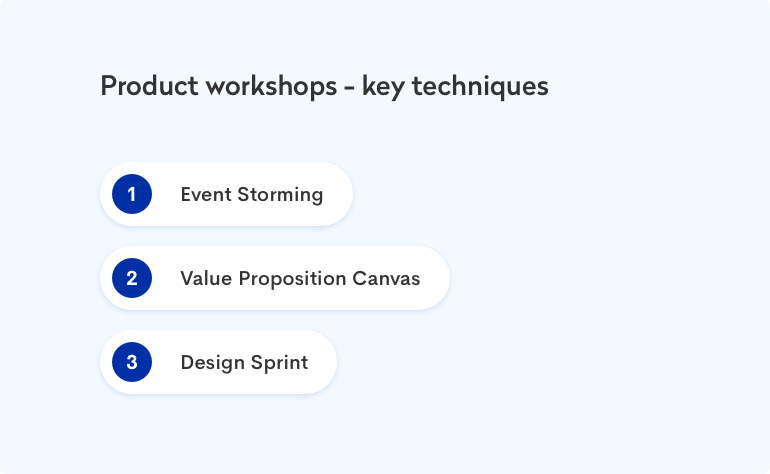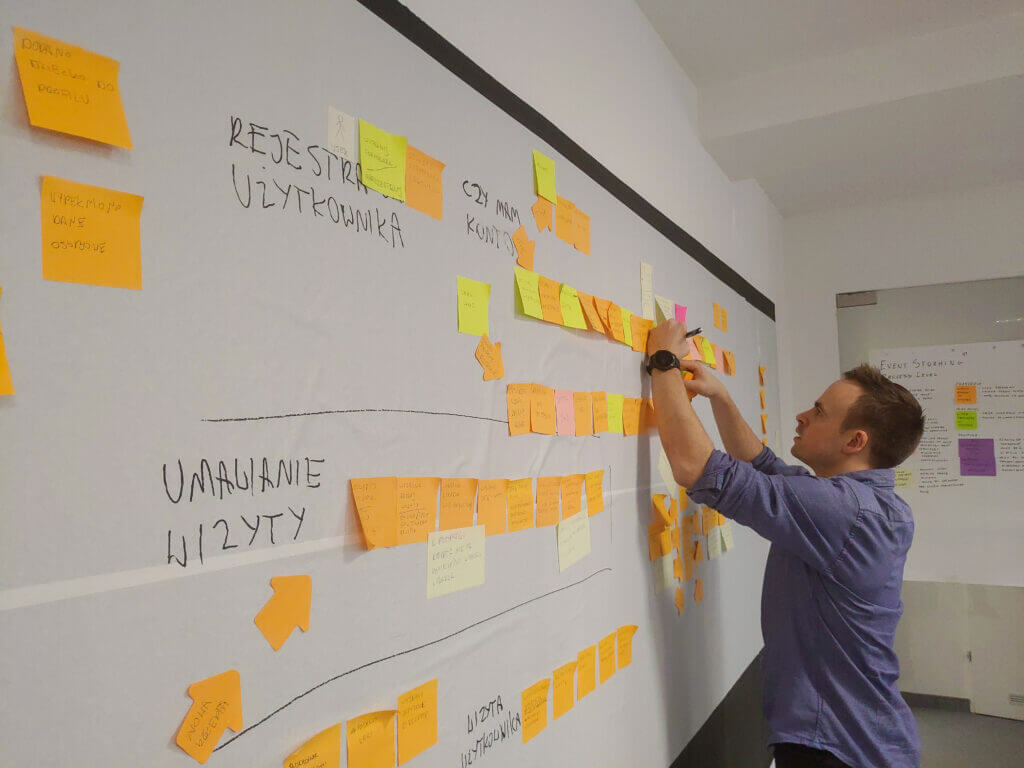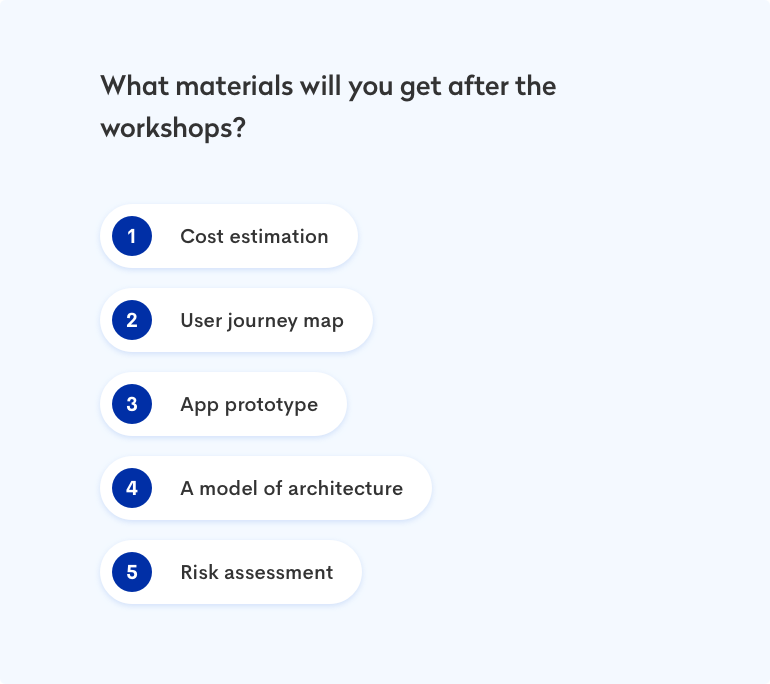Building an innovative digital product that will successfully hit the market calls for a good preparation process, wide knowledge, and a well-thought-out plan. Turning an idea into a fully functioning product is a challenge, and sometimes business owners don’t have a clear vision of their ideas or find it difficult to convert them into technical needs. Starting the development process, in this case, may cause problems and can become ineffective and cost-consuming.So how should you get ready to verify your product idea and start the development process efficiently? Check out what you can get from dedicated product workshops.
At Blurify we have been organizing workshops for a long time, gradually adjusting their scope to the clients’ needs by introducing new, more goal-oriented methods. Read the article to learn more about our product workshops and discover some important techniques that make them stand out from the crowd.
Software product workshops – why should you give them a try?
Product workshops are a perfect combination of effective methods to fully analyze, understand, and organize your app idea. It’s a good way to get ready for the app development process. Most beneficial is the time spent evaluating every single process in the application, and making a real breakdown. It’s very useful when you want to define the core product features and get a complete picture of app operation. In other words, you can check which functionalities play the most important roles in the system, which you can modify and which are not necessary at all. It’s also a great opportunity to talk about your vision with experts, assess its potential and listen to their suggestions.
We have presented 10 different situations when workshops will be good for you. Check them out and learn when it’s time to participate in one of those by downloading our free checklist:
[checklist_banner]Gathering essential knowledge about your product and preparing good specifications will be very useful for developers who are going to start coding. When they understand the vision and get the whole picture of how the product works, they can plan further development more efficiently and with fewer unexpected roadblocks. Another advantage is that the software house will be able to prepare a more precise cost estimate for you, all based on the information gathered during the workshops. And if you’re worried about the workshop agenda, you won’t be disappointed. The sessions are perfectly tailored to the needs, the project’s scope, and stage.
Now, keep on reading to learn what techniques we use to analyze the application step by step.
Discovery phase – Strategic target group analysis
The workshop usually starts with a discovery phase, during which we focus on clients’ needs and target group analysis. To achieve our goals, we have a useful technique called Value Proposition Canvas – a perfect instrument to understand the potential product’s users.
Analyzing the target group and discussing their preferences, problems, and pain points are essential to achieving product-market fit. Although it sounds like a basic start for creating any product for the market, the value of this stage is very often underestimated, overlooked, or badly described. This is why we always spend some time to get the whole picture of the product and learn more about its target audience, and what’s really important – discover the value behind the product and its ability to solve users’ problems.
We focus on customers’ profiles and discuss the following aspects:
- jobs-to-be-done – all the tasks customer is trying to perform (these could be both – social and functional), and the problems they have to face,
- pains – all the negative experiences that disturb getting the job done,
- gains – needs, expectations, sources of positive experiences.
Once we get ready with those profiles we move to create a Product Value Map, including all the gain creators, and pain relievers from the product perspective. For example, we describe how your product can ease the customer’s pain. The goal is to find the fit between the value proposition canvas and the customer profile, and ensure that your product will be tailored to needs and expectations.
Event Storming – The heart of product workshops
After the discovery phase, the team is equipped with the essential knowledge to start the next important part of the session. This is the Event Storming phase, during which we create a visualization of the processes taking place in the application. This is a very insightful and valuable part of the whole workshop – in it, we assess the application complexity and analyze its operation step by step by examining specific events taking place in it. We take a closer look at the user’s role and how his specific behavior influences the occurrence of specific events.
To present everything clearly, everyone uses sticky notes to describe various events taking place in the system: for example, “payment was collected.” Then we identify the user’s actions and group all the information to present a clear path for the application’s operation.
Event Storming is valuable to both the client and developers, as it helps to understand the product’s context, main features, and all the associated processes, including integrations with external systems. By analyzing the product this way, you mitigate the risk of unexpected issues and uncertainties arising.
Design Sprint – Our process
The Event Storming phase provides a lot of inspiring information and helps us prepare for the next part of the workshop. By understanding the processes taking place in the application, we can start the next stage effectively and dig deeper into graphics solutions. At Blurify, we use selected elements of the Design Sprint technique, and the scope of the process is always well-thought-out and adjusted to all the needs.
Competitive analysis
Conducting competitive analysis can provide a lot of inspiration and give you an advantage in the market. Researching competitors’ solutions and gaining insights into their tactics or ideas help us collect the most interesting concepts. To be more precise, we focus on analyzing product design solutions. Let’s say, as an example, that we’re working on a possible design for the process of buying tickets in the application. So we look for similar existing solutions, compare them, discuss the views, look for the pros and cons of each of them, and identify any missing points. Then it’s much easier to work on our solutions.
Crazy Eights – brainstorming new ideas
Next, we move on to another interesting tool successfully used in the Design Sprint, called Crazy Eight. In this model, we involve every workshop participant, and everyone has to create their own basic project.
The time allocated for this task is approx. 8 minutes – just enough to put your idea on paper and avoid additional analyses and rationalization. As a result, we usually reach interesting, innovative concepts that can see the light of day quickly. The best ideas for views are selected by voting – those with the largest number of votes are used in further work and a prototype is created using them as its basis.
What happens next?
By now, we’re coming to the end of the workshop and it’s time to organize all the gathered information and create a useful summary. After this stage, we prepare materials for the client including the following:
-
- Project cost estimation: The acquired knowledge will allow us to prepare more precise project costs, along with dividing the project into specific functionalities.
- User Journey Diagram: We’ll create a user flow map for you.
- Prototype: Our designers will prepare a clickable prototype to illustrate how the application works.
- Architecture model: You will get the scheme of the app’s architecture.
- Risk register: We’ll identify all the risks that came up during product workshops. Each entry (single risk) will consist of a title, a short description, the impact on further work or the current product, a risk handling proposal, and an assessment of the risk’s significance.
Do you need to verify your app idea, discuss the functionalities, and prepare for the app development process? Contact us and book a workshop!





